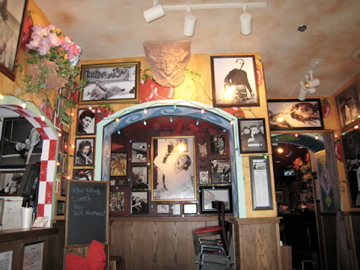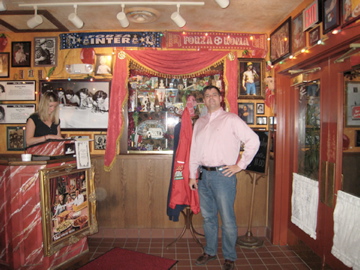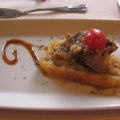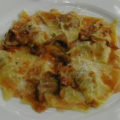I instinctively dislike chain restaurants: when someone says “Let’s eat at a [name of chain restaurant],” I wince. And it’s getting harder and harder to find a restaurant in the US that isn’t part of a chain. However, my instincts may be out of date: chain restaurant food seems to be improving. During this recent trip I ate at TeKei’s (Chinese/Thai), Razzoo’s (Cajun), Sarovar (north and south Indian), and something else with a southern (American) theme. I think they’re all chain franchises, but they were also all good. I still prefer to support local and personal cooking creativity where possible, but… sometimes you gotta make do.
What puzzles me is the concept of waiting to get a seat at a restaurant. In 15 years in Italy, I have almost never waited for a restaurant. I’m sure it must have happened once or twice, but I can’t actually remember a single instance. The handful of times I can remember arriving somewhere and finding it full, there was always someplace just as good nearby to go to instead.
But, in the US, no matter how saturated with restaurants an area may be, it’s not uncommon to arrive at a restaurant and find you have to wait half an hour for a table – even though American restaurants are usually HUGE compared with Italian ones, and manage several seatings per table per night, as Americans rarely linger over their meals. I can’t figure it out. Maybe Americans simply eat out more often than Italians (with today’s prices at Italian restaurants, that wouldn’t be surprising).
Restaurant congestion is so bad that, throughout my recent trip, everyone I had lunch with wanted to eat at 11:30 am to avoid the rush. If I hadn’t had jet lag, I would never have got used to this, but it was good preparation for CES, where, if you don’t eat early, you don’t eat at all.
America seems to be obsessed with eating. You can’t go anywhere without being bombarded by advertising for food. It’s effective, too: hearing or reading adjective-stuffed descriptions and seeing perfectly-staged food photographs (there’s an art to it), I always get hungry.
I can’t remember ever hearing food advertised on Italian radio (not that I listen to it regularly). Nor are restaurants advertised on TV in Italy, except McDonald’s. I guess that’s because there aren’t any non-fast-food restaurant chains in Italy (well, there is one, Pastarito – I don’t recommend it), and it doesn’t make economic sense for a single restaurant to advertise nationally.
In America, the marketing doesn’t stop once they’ve got you in the restaurant. The typical American menu is larded with sensual adjectives: “creamy this, delicately folded into tangy that, with a hint of zesty the other…” Some menus include photos, though the food on your plate rarely comes out quite as beautifully. All of this – words, pictures, page layout, fonts – is designed to encourage you to buy the items on which the restaurant makes the biggest profit margin. The waiter may also, asked or unasked, recommend those high-margin items.
There’s no art of selling in Italian menus: they generally only give the name of the dish and a price. In most Italian restaurants, this is all that’s necessary, because most stick to well-known classics with maybe one “house specialty” dish. In the rare cases that you don’t know what a dish’s name means, you ask the waiter, who gives you a bare description: “pasta with sauteed eggplant and salted ricotta.”
The fancier restaurants do tend to be more creative and therefore need to explain their dishes, but the explanations are usually simple statements of fact: “sauteed local trout with diced vegetables” – which hardly does justice to one of Lanterna Verde‘s amazing dishes. But then, the food at Lanterna Verde is so good that you need not be seduced into eating it, and you will certainly not be disappointed, whatever you choose.







